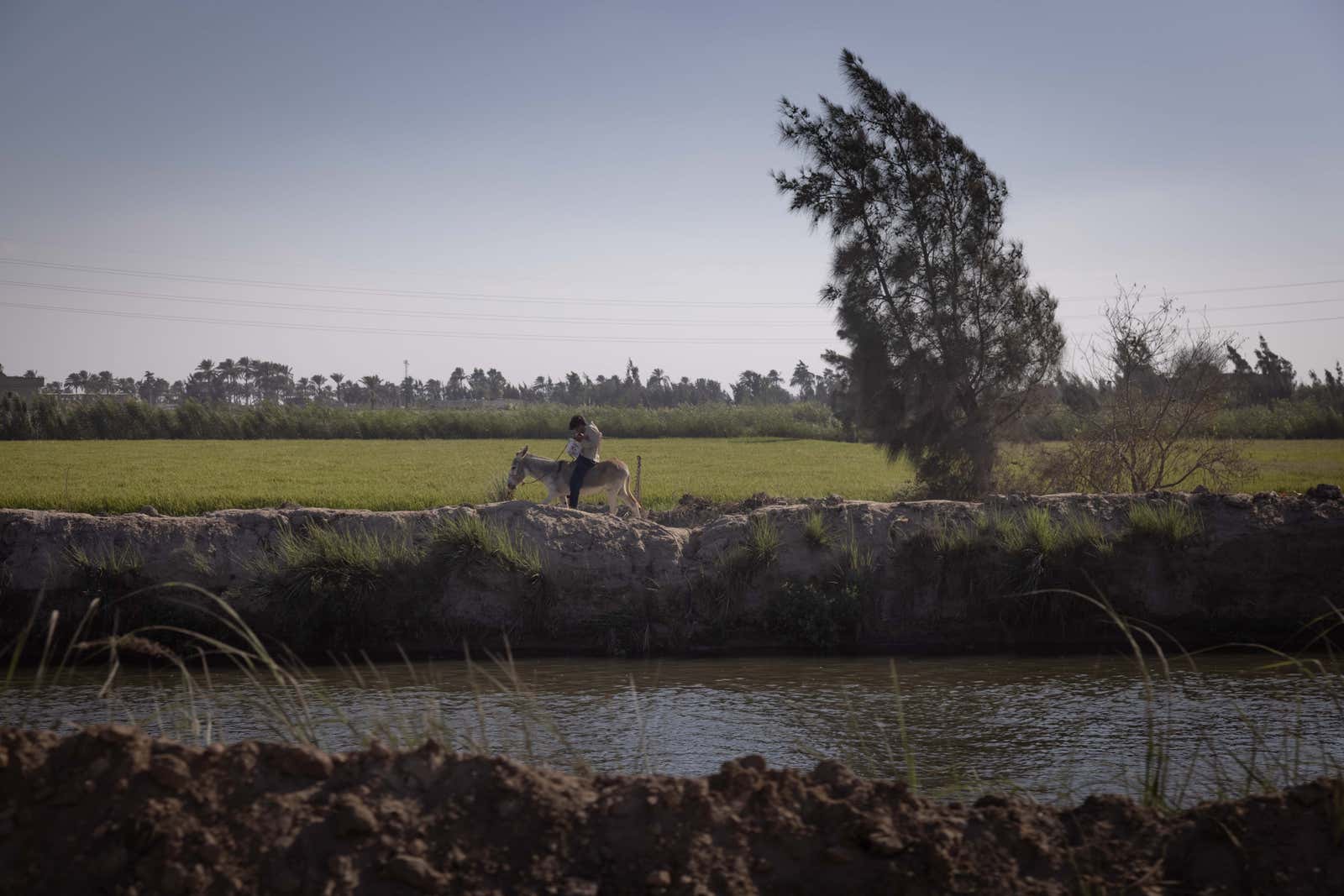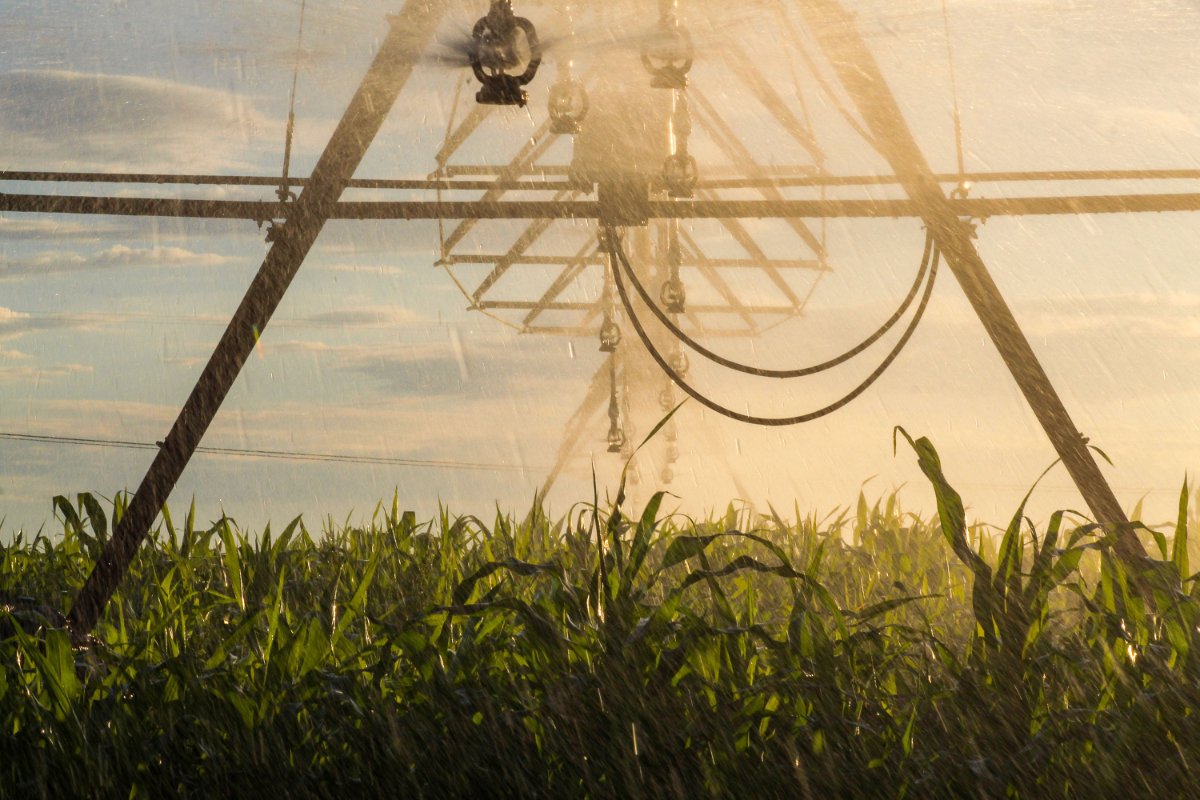Home>Gardening News and Trends>Latest News>How Did Irrigation Canals Expand Farmland In Egypt


Latest News
How Did Irrigation Canals Expand Farmland In Egypt
Modified: January 22, 2024
Expand your knowledge on the latest news about the expansion of farmland in Egypt through irrigation canals. Discover how this development is reshaping the agricultural landscape.
(Many of the links in this article redirect to a specific reviewed product. Your purchase of these products through affiliate links helps to generate commission for Chicagolandgardening.com, at no extra cost. Learn more)
Table of Contents
- Introduction
- The Importance of Irrigation Canals in Ancient Egypt
- The Origins of Irrigation Canals in Egypt
- The Expansion of Farmland through Irrigation Canals
- The Design and Construction of Irrigation Canals
- The Impact of Irrigation Canals on Egyptian Society
- Challenges and Limitations of Irrigation Canals in Egypt
- Conclusion
Introduction
Welcome to ancient Egypt, a civilization known for its fascinating history, remarkable architectural achievements, and innovative agricultural practices. At the heart of Egyptian agriculture was the ingenious system of irrigation canals, which enabled the expansion of farmland and supported the flourishing of one of the greatest civilizations in human history.
Irrigation canals played a crucial role in the sustenance and growth of ancient Egyptian society. The abundance of water resources, provided by the Nile River, allowed Egyptians to develop sophisticated irrigation techniques that transformed the arid desert into fertile lands. With the implementation of irrigation canals, Egypt became a land of lush fields and bountiful harvests, creating a stable food supply for its population.
This article will delve into the importance of irrigation canals in ancient Egypt, exploring their origins, the expansion of farmland they facilitated, and their impact on Egyptian society. We will also examine the design and construction of these canals, as well as the challenges and limitations that were faced along the way.
Join us on this journey through time as we unravel the secrets behind the remarkable success of irrigation canals in ancient Egypt.
The Importance of Irrigation Canals in Ancient Egypt
The Nile River was the lifeblood of ancient Egypt, providing the necessary water for agricultural practices in an otherwise arid and unforgiving environment. The ingenious system of irrigation canals allowed Egyptians to harness the power of the Nile and expand their farmland, thus ensuring the survival and prosperity of their civilization.
Without the implementation of irrigation canals, the fertile floodplains of the Nile would have been limited to the immediate vicinity of the riverbanks. However, the construction of canals enabled Egyptians to transport water to more distant areas, extending the reach of farmland and maximizing agricultural productivity.
By diverting water from the Nile into these canals, Egyptians could control the timing and amount of water distributed to their fields. This allowed them to overcome the challenges posed by the irregular flooding patterns of the Nile and ensure a steady supply of water throughout the year.
The agricultural significance of irrigation canals in ancient Egypt cannot be overstated. They provided the means to cultivate various crops, including wheat, barley, flax, and vegetables, which formed the staple diet of the Egyptian population. The availability of surplus crops not only sustained the people but also allowed for trade and the development of a prosperous economy.
Moreover, the expansion of farmland through the use of irrigation canals played a crucial role in the social and political structure of ancient Egypt. The surplus agricultural produce provided the Pharaoh with the means to support a large population, maintain a standing army, and undertake grand construction projects, such as the pyramids and temples that still stand as testaments to ancient Egyptian civilization.
The reliance on irrigation canals also fostered a sense of cooperation and community among the Egyptian people. The maintenance and management of these canals required collective effort, leading to the formation of organized committees or advisory boards that oversaw their operation. This sense of communal responsibility helped to strengthen social ties and contribute to the stability of Egyptian society.
In the next section, we will explore the origins of irrigation canals in ancient Egypt and how they contributed to the expansion of farmland in this remarkable civilization.
The Origins of Irrigation Canals in Egypt
The origins of irrigation canals in ancient Egypt can be traced back to the early dynastic period, around 3100 BCE. The Egyptians recognized the potential of the Nile River and its annual flooding as a vital source of water and nutrients for their agricultural endeavors.
Initially, Egyptians relied on natural channels and channels created by the flooding of the Nile to distribute water to their farmland. However, as their population grew and the demand for food increased, they realized the need for a more efficient and controlled system of irrigation. This led to the construction of man-made canals.
The construction of irrigation canals required meticulous planning and engineering skills. The ancient Egyptians carefully surveyed the land, studying the topography and ensuring that the canal routes followed the natural contours of the landscape. This allowed for a more efficient flow of water and minimized the need for excessive excavation or land alteration.
The earliest canals were likely simple channels dug into the ground, gradually evolving into more complex systems with the advancement of engineering techniques. These canals often incorporated structures such as gates, weirs, and sluices to regulate the water flow and distribute it to different fields based on their needs.
One of the most remarkable irrigation projects in ancient Egypt was the construction of the Bahr Yusef canal during the reign of Pharaoh Senusret III in the Middle Kingdom. This colossal canal, stretching over 375 kilometers, facilitated the cultivation of vast areas of previously unusable land, contributing to the expansion of agriculture and economic growth.
The construction and maintenance of irrigation canals in ancient Egypt involved the collective efforts of the population, from laborers and engineers to government officials. The Pharaohs, as the rulers, played a pivotal role in overseeing these projects and ensuring their successful completion.
The ingenuity and dedication of the Egyptians in developing their irrigation system allowed them to maximize the agricultural potential of the Nile River. The use of irrigation canals enabled them to overcome the challenges of the desert environment and create a sustainable food supply, laying the foundation for the remarkable prosperity and longevity of their civilization.
In the next section, we will explore how the expansion of farmland through irrigation canals transformed ancient Egypt into a land of abundance.
The Expansion of Farmland through Irrigation Canals
The implementation of irrigation canals in ancient Egypt revolutionized agriculture and led to a significant expansion of farmland. By harnessing the power of the Nile River, Egyptians were able to transform barren desert regions into fertile fields, supporting their growing population and establishing a thriving civilization.
Prior to the development of irrigation canals, the availability of arable land in Egypt was limited to the fertile floodplains along the Nile River. However, with the construction of canals, water could be transported to areas further away from the riverbanks, allowing for the cultivation of previously unusable land.
These canals not only extended the reach of agricultural activities but also made it possible to cultivate different types of crops in various regions. Areas with different soil types and microclimates could be utilized for specific crops, optimizing agricultural output and diversifying the Egyptian diet.
The expansion of farmland through irrigation canals greatly increased Egypt’s agricultural productivity. Farmers were able to grow a wide range of crops, such as wheat, barley, flax, and vegetables, in larger quantities and with greater efficiency. This surplus production not only fed the expanding population but also created a surplus for trade and export.
The availability of a surplus enabled the Egyptians to establish trade networks with neighboring regions and even distant civilizations. Egypt became a key player in the exchange of goods, with agricultural products being highly desired commodities.
Moreover, the expansion of farmland through irrigation canals had profound implications for the social and economic structure of ancient Egypt. As agricultural productivity increased, so did the wealth and influence of the ruling elite. The Pharaohs and the nobility controlled vast estates that were supported by the labor of the farmers and the infrastructure of the irrigation system.
The surplus produced from these lands allowed the Pharaohs to maintain a powerful military, construct monumental structures, and invest in cultural and intellectual pursuits. Trade and commerce flourished, and the economy of ancient Egypt became one of the most prosperous in the ancient world.
The expansion of farmland through irrigation canals also had a significant impact on the social fabric of Egyptian society. The surplus production created a class of skilled workers and artisans who were involved in the production and trade of agricultural goods. This specialization led to the growth of cities and the development of a complex social hierarchy.
In the next section, we will delve into the design and construction of irrigation canals, examining the engineering innovations that made this remarkable agricultural system possible.
The Design and Construction of Irrigation Canals
The design and construction of irrigation canals in ancient Egypt were impressive feats of engineering that required careful planning, precise measurements, and extensive labor. The Egyptians developed innovative techniques to ensure the efficient distribution of water and maximize the effectiveness of their irrigation system.
One key aspect of canal design was the consideration of the natural topography of the land. The ancient Egyptians surveyed the terrain and identified the optimal routes for the canals, taking advantage of natural depressions and contours to minimize the need for extensive excavation.
The basic design of an irrigation canal involved a long, narrow channel that connected the Nile River to the agricultural fields. These canals were typically dug into the ground, but in some cases, sections of canals were constructed using stones or bricks to reinforce their banks and prevent erosion.
To regulate the flow of water, the Egyptians incorporated various structures into the canal system. Weirs or gates were installed at strategic points along the canals to control the water level and ensure an even distribution of water to different fields. Sluices and drains were also used to divert water into specific areas or remove excess water during the flood season.
The construction of irrigation canals required a significant investment of labor and resources. The process involved mobilizing a large workforce, including both skilled laborers and unskilled workers. Excavation teams used simple tools such as shovels and wooden scoops to dig the canals, while more advanced structures were sometimes built using mud bricks or stone.
The maintenance of the canals was also crucial to ensure their effectiveness. Egyptians regularly removed debris and sediment that could obstruct the flow of water. They also addressed any damages or blockages, ensuring that the canals remained in good condition and the irrigation system operated smoothly.
The construction and maintenance of the irrigation canals were often overseen by government officials or local administrators who coordinated the efforts of the labor force. These officials ensured that the canals were properly maintained, the water was distributed fairly, and disputes over water rights were resolved.
Though the design and construction of irrigation canals in ancient Egypt may seem primitive by modern standards, they were a testament to the ingenuity and resourcefulness of the Egyptians. The system they developed enabled them to harness the power of the Nile River and transform the desert landscape into productive farmland, ultimately laying the foundation for their flourishing civilization.
In the next section, we will explore the impact of irrigation canals on Egyptian society, including their influence on agriculture, economy, and social structure.
The Impact of Irrigation Canals on Egyptian Society
The implementation of irrigation canals in ancient Egypt had a profound and far-reaching impact on various aspects of Egyptian society. These innovative agricultural systems revolutionized not only the way Egyptians cultivated their land but also the economy, social structure, and cultural development of the civilization.
One of the most significant impacts of irrigation canals was their contribution to agricultural productivity. The ability to control and distribute water with precision allowed Egyptians to cultivate a wide range of crops throughout the year. This resulted in a surplus of food, ensuring the sustenance of the population and creating economic opportunities.
The increased agricultural productivity fueled the growth of trade and commerce within Egypt and with neighboring regions. Egypt became a hub of agricultural production, exporting surplus crops such as grain, vegetables, and textiles. This trade brought wealth to the country and allowed the Pharaohs to build a powerful and prosperous nation.
The surplus food production also supported the expansion of Egyptian cities and the development of a complex social structure. As the population grew, specialized professions emerged, such as artisans, traders, and scribes, who contributed to the overall prosperity of the society.
Moreover, the success of irrigation canals led to a more centralized governance system. The construction and maintenance of these canals required organization, coordination, and management. Government officials and local administrators were responsible for overseeing the distribution of water, resolving conflicts over water rights, and ensuring fair agricultural practices.
The control and management of irrigation canals also played a role in the religious beliefs and rituals of ancient Egyptians. The Nile River was considered sacred, and the ability to manipulate its waters through the canals was seen as a divine gift. The Pharaoh, often regarded as the living representative of the gods, was responsible for maintaining the balance of the natural world, including the flow of the Nile and the irrigation canals.
Additionally, the use of irrigation canals fostered a sense of community and cooperation among the Egyptian people. The maintenance and operation of the canals required collective effort, leading to the formation of work committees and mutual assistance among farmers. This sense of shared responsibility and mutual support contributed to the social cohesion and stability of Egyptian society.
The impact of irrigation canals on Egyptian society cannot be overstated. These systems of water management facilitated the growth of agriculture, economy, social structure, and cultural development. They laid the foundation for the remarkable achievements of ancient Egypt and ensured its survival and prosperity for centuries to come.
In the next section, we will explore the challenges and limitations that the Egyptians faced in their implementation and maintenance of irrigation canals.
Challenges and Limitations of Irrigation Canals in Egypt
While the implementation of irrigation canals in ancient Egypt brought forth numerous benefits, it also presented a unique set of challenges and limitations that the Egyptians had to overcome in order to maintain a successful agricultural system.
One major challenge was the constant management and maintenance required for the canals. The Nile River’s flooding patterns were unpredictable, and the canals needed to be monitored and adjusted accordingly to ensure the proper distribution of water. Sediment accumulation and blockages were common issues that required regular maintenance and dredging.
Furthermore, the construction and maintenance of irrigation canals were labor-intensive tasks that demanded significant manpower and resources. The excavation of canals was a time-consuming and physically demanding process. The Egyptians had to rely on a large workforce, which often included slaves and peasants, to dig and maintain the canals effectively.
Another limitation of irrigation canals was the reliance on the Nile River itself. While the river provided a reliable source of water, it was subject to periods of drought or unusually low flood levels. During these times, the availability of water for irrigation could be compromised, affecting crop yields and overall agricultural productivity.
Additionally, the development of an extensive canal network was limited by the available technology and engineering knowledge of the time. Ancient Egyptians primarily used simple tools and manual labor in the construction process. As a result, the size and capacity of the canals were constrained by the limitations of their engineering techniques.
Moreover, the distribution of water through the canals may not have always been equitable. The influence and power of the wealthy landowners could result in some farmers receiving more water than others, leading to potential disparities in agricultural productivity and social inequalities.
Despite these challenges and limitations, the Egyptians implemented innovative strategies to mitigate their impacts. They developed effective flood control techniques to manage irregular flooding patterns, employed rigorous maintenance practices to keep the canals operational, and used effective water allocation systems to ensure fair distribution.
The limitations and challenges associated with irrigation canals in ancient Egypt highlight the resourcefulness and adaptability of the Egyptians. Their ability to overcome these obstacles and sustain a successful agricultural system speaks to their ingenuity and determination in harnessing the power of water for the benefit of their civilization.
In the final section, we will reflect on the significance and enduring legacy of irrigation canals in ancient Egypt.
Conclusion
The implementation of irrigation canals in ancient Egypt was a remarkable achievement that played a crucial role in the survival, growth, and prosperity of one of the most magnificent civilizations in history. The canals allowed Egyptians to harness the power of the Nile River and transform the arid desert into fertile agricultural lands.
These canals had a profound impact on Egyptian society, enabling the expansion of farmland, increasing agricultural productivity, and sustaining a growing population. They supported the development of a strong economy through trade and surplus food production, allowing the Pharaohs to undertake grand construction projects and foster cultural and intellectual pursuits.
Despite facing challenges such as irregular flooding patterns, labor-intensive construction, and the limitations of technology, the Egyptians showcased their ingenuity and resourcefulness in managing and maintaining their irrigation system.
The significance of irrigation canals in ancient Egypt extended beyond agriculture and economics. They shaped the social structure, fostering a sense of community and cooperation among the people. The canals also held religious and cultural importance, with the Nile River and its manipulation through the canals being seen as a divine gift.
The legacy of irrigation canals in ancient Egypt can still be seen and appreciated today. The remnants of these canals serve as a testament to the remarkable achievements of ancient Egyptian engineering and the profound impact they had on the society and landscape.
In conclusion, the implementation of irrigation canals was a cornerstone of ancient Egyptian civilization, transforming the arid desert into a land of abundance. These canals facilitated the expansion of farmland, increased agricultural productivity, and supported the growth of trade, culture, and society. The ingenuity, dedication, and cooperative spirit of the Egyptians in developing and maintaining this remarkable irrigation system is an enduring testament to their remarkable achievements.






